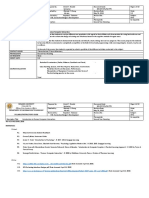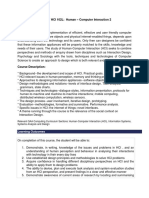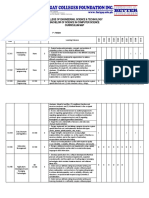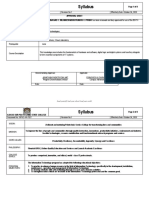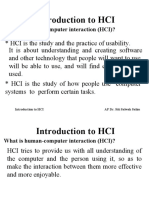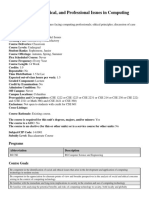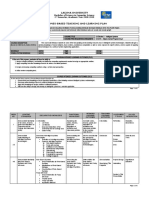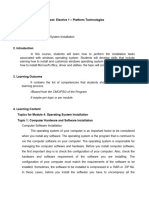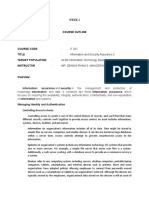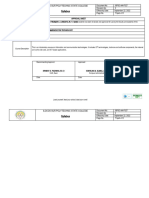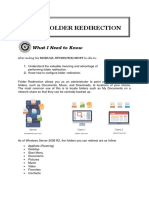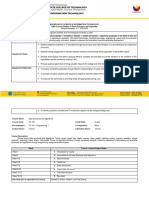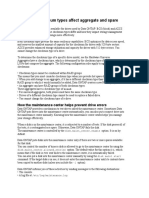Universiy of Cagayan Valley
New Site Campus, Balzain, Tuguegarao City
College of Information Technology
First Semester, S.Y.2024-2025
MODULE IN HUMAN COMPUTER INTERACTION 2
Course Title: Human Computer Interaction 2
Course Credit: 3 units/ 5 hrs per week
Course Description:
Students in this course will learn the importance of human computer interaction design
and the effectiveness of user-centered design. The course will cover a survey of methods
frequently used by the HCI profession, such as usability testing and prototyping, as well as
general design principles and how to use design guidelines. A particular emphasis will be placed
on usability for Web site engineering, and students will apply knowledge from the field in the
design and construction of user-centered Web sites.
LEARNING OUTCOMES:
At the end of the module the students expected to:
Cognitive
Understand core cognitive aspects of interaction design.
Learn the basic physiological, perceptual, and cognitive components of human learning
and memory.
Gain theoretical knowledge of and practical experience in the fundamental aspects of
designing and implementing user interfaces.
Affective
Learn to analyze interaction problems from a technical, cognitive, and functional
perspective
Learn about multimodal displays for conveying and presenting information.
Psychomotor
Have practiced a variety of simple methods for designing and evaluating the quality of
user interfaces and spatial displays.
Develop an awareness of the range of general human-computer interaction issues that
must be considered when designing information systems.
Design and construct user-centered Web sites.
Intended Learning Outcomes:
At the end of the lesson, the students will be able to:
Understand what is HCI and its importance.
Know the different principles of HCI
Identify different principles of HCI
Identify different HCI Design Rules
Know the different specific HCI guidelines
Distinguish different categories of HCI
Identify the different examples of HCI guidelines
Identify the Human factors in HCI Theories
Know more on the different capabilities of the human body.
Understand about Human Information Processing
Understand about Sensation and Perception of Information
1
� Universiy of Cagayan Valley
New Site Campus, Balzain, Tuguegarao City
College of Information Technology
First Semester, S.Y.2024-2025
Understand how is the process of HCI design
Identify the different interface selection options
Describe wire framing
Understand “NAÏVE” design examples
Identify the different user interface layer
Understand UI layer and its execution framework
Describe Input and Output level
Know the process of input and generate output
Understand the User Interface Development Toolkit
Describe Interactive system development framework
Differentiate Model, View and Controller
Discuss the different examples of Model, View and Controller
Discuss the user interface evaluation
Describe the communication and collaboration models.
Discuss the future of HCI
Differentiate Non-WIMP/Natural /Multimodal Interfaces
Understand Non-WIMP/Natural /Multimodal Interfaces
Differentiate Mixed and augmented Reality
Discuss Natural/ Immersive/experimental Interaction
Differentiate High-end Cloud Service and Multimodal Client Interaction
Understand Mobile and Handheld Interaction
Design and Construct user-centered Web sites
LESSON 1. INTRODUCTION TO HCI
Learning Activities:
What HCI Is and Why It Is Important?
Human–computer interaction (HCI)
– It is a cross-disciplinary area (e.g., engineering, psychology, ergonomics, and design) that
deals with the theory, design, implementation, and evaluation of the ways that humans use and
interact with computing devices.
Interaction
– It is a concept to be distinguished from another similar term, interface.
– It refers to an abstract model by which humans interact with the computing device for a
given task, and an interface is a choice of technical realization (hardware or software)
of such a given interaction model.
2
� Universiy of Cagayan Valley
New Site Campus, Balzain, Tuguegarao City
College of Information Technology
First Semester, S.Y.2024-2025
Principles of HCI
HCI design is generally difficult, mainly because it is a multiobjective task that involves
simultaneous consideration of many things, such as the types of users, characteristics of the
tasks, capabilities and cost of the devices, lack of objective or exact quantitative evaluation
measures, and changing technologies.
These HCI principles are general, fundamental, and common sensual, applicable to almost any HCI
design situation.
1. “Know Thy User”
– The foremost creed in HCI is to devise interaction and interfaces around the target
users.
– This overall concept was coined by Hansen in year 1971, even though the so- called
user-centered design approach has become a buzzword only in recent years.
2. Understand the Task
– This principle is to base HCI design on the understanding of the task.
– The term task refers to the job to be accomplished by the user through the use of the
interactive system.
– In fact, understanding the task at hand is closely related to the interaction modeling
and user analysis.
3. Reduce Memory Load
– Designing interaction with as little memory load as possible is a principle that also
has a theoretical basis. Humans are certainly more efficient in carrying out tasks that
require less memory burden, long or short term.
4. Strive for Consistency
– In the longer term, one way to unburden the memory load is to keep consistency.
This applies to:
(a) Both within an application and across different applications and
(b) Both the interaction model and interface implementation.
5. Remind Users and Refresh Their Memory
3
� Universiy of Cagayan Valley
New Site Campus, Balzain, Tuguegarao City
College of Information Technology
First Semester, S.Y.2024-2025
– Any significant task will involve the use of memory, so another good strategy is to
employ interfaces that give continuous reminders of important information and
thereby refresh the user’s memory.
6. Prevent Errors/Reversal of Action
– While supporting a quick completion of the task is important, error- free operation is
equally important. As such, the interaction and interface should be designed to avoid
confusion and mental overload.
– There is always a chance that the user will make mistakes but easy-to-forget
feature is to allow an easy reversal of action.
7. Naturalness
– This HCI principle is to favor “natural” interaction and interfaces.
– Naturalness refers to a trait that is reflective of various operations in our everyday
life.
HCI Design Rules
The design rules exist to prevent a designer from pursuing a design options that would be likely
lead to an unusable system. Poorly designed system can result into serious catastrophe.
Example Scenario:
The nuclear accident at Three Mile Island in year 1979. This accident occurred because the
control panel was programmed for the light to go off once the computer had sent the signal to
close the valve, which is not the same as when the valve was actually closed. The workers
thought the valve was closed when it was actually opened which resulted into the overheating of
the reactor.
Designing for maximum usability - the goal of interaction design
Principles of usability
– general understanding
Standards and guidelines
– direction for design
Design patterns
– capture and reuse design knowledge
Types of design rules
principles
– abstract design rules
– low authority
– high generality
standards
– specific design rules
– high authority
– limited application
guidelines
– lower authority
4
� Universiy of Cagayan Valley
New Site Campus, Balzain, Tuguegarao City
College of Information Technology
First Semester, S.Y.2024-2025
– more general application
Principles to support usability
1. Learnability
– the ease with which new users can begin effective interaction and achieve
maximal performance.
2. Flexibility
– the multiplicity of ways the user and system exchange information.
3. Robustness
– the level of support provided the user in determining successful achievement and
assessment of goal- directed behavior.
Principles of learnability
Predictability
– determining effect of future actions based on past interaction history
– operation visibility
Synthesizability
– assessing the effect of past actions
– immediate vs. eventual honesty
Familiarity
– how prior knowledge applies to new system
– guess ability, affordance
Generalizability
– extending specific interaction knowledge to new situations
Consistency
– likeness in input/output behavior arising from similar situations or task objectives
Principles of Flexibility
Dialogue initiative
– freedom from system-imposed constraints on input dialogue
– system vs. user pre-emptiveness
Multithreading
– ability of system to support user interaction for more than one task at a time
– concurrent vs. interleaving; multimodality
Task migratability
– passing responsibility for task execution between user and system
Substitutivity
– allowing equivalent values of input and output to be substituted for each other
– representation multiplicity; equal opportunity
Customizability
– modifiability of the user interface by user (adaptability) or system (adaptivity)
Principles of Robustness
Observability
– ability of user to evaluate the internal state of the system from its perceivable
representation
5
� Universiy of Cagayan Valley
New Site Campus, Balzain, Tuguegarao City
College of Information Technology
First Semester, S.Y.2024-2025
– browsability; defaults; reachability; persistence; operation visibility
Recoverability
– ability of user to take corrective action once an error has been recognized
– reachability; forward/backward recovery; commensurate effort
Responsiveness
– how the user perceives the rate of communication with the system
– Stability
Task conformance
– degree to which system services support all of the user's tasks
– task completeness; task adequacy
Using design rules
suggest how to increase usability
differ in generality and authority
Standards
Set by national or international bodies to ensure compliance by a large community of
designer’s standards require sound underlying theory and slowly changing technology.
Hardware standards more common than software high authority and low level of detail.
ISO 9241 defines usability as effectiveness, efficiency and satisfaction with which users
accomplish tasks.
Guidelines
more suggestive and general
many textbooks and reports full of guidelines
abstract guidelines (principles) applicable during early life cycle activities
detailed guidelines (style guides) applicable during later life cycle activities
understanding justification for guidelines aids in resolving conflicts
Golden rules and heuristics
Broad run-in design rules
Useful check list for good design
Better design using these than using nothing!
Different collections e.g.
– Jakob Nielsen’s 10 Heuristics
– Ben Shneiderman’s 8 Golden Rules
– Donald Norman’s 7 Principles
Jakob Nielsen’s 10 Heuristics
1. Visibility of system status.
2. Match between system and real world.
3. User control and freedom.
4. Consistency and standards.
5. Error prevention.
6. Recognition rather than Recall.
6
� Universiy of Cagayan Valley
New Site Campus, Balzain, Tuguegarao City
College of Information Technology
First Semester, S.Y.2024-2025
7. Flexibility and efficiency of use.
8. Aesthetic and minimalist design.
9. Help, diagnosis and recovery from errors.
10. Documentation and Help
Ben Shneiderman’s 8 Golden Rules
1. Strive for consistency
2. Enable frequent users to use shortcuts
3. Offer informative feedback
4. Design dialogs to yield closure
5. Offer error prevention and simple error handling
6. Permit easy reversal of actions
7. Support internal locus of control
8. Reduce short-term memory load
Donald Norman’s seven (7) principles
1. Use both knowledge in the world and knowledge in the head.
2. Simplify the structure of tasks.
3. Make things visible: bridge the gulfs of Execution and Evaluation.
4. Get the mappings right.
5. Exploit the power of constraints, both natural and artificial.
6. Design for error.
7. When all else fails, standardize.
HCI design pattern
An approach to reusing knowledge about successful design solutions
Originated in architecture: Alexander
A pattern is an invariant solution to a recurrent problem within a specific context.
Examples
– Light on Two Sides of Every Room (architecture)
– Go back to a safe place (HCI)
Patterns do not exist in isolation but are linked to other patterns in languages which
enable complete designs to be generated.
Characteristics of patterns:
– capture design practice not theory
– capture the essential common properties of good examples of design
– represent design knowledge at varying levels: social, organizational, conceptual,
detailed
– embody values and can express what is humane in interface design
– are intuitive and readable and can therefore be used for communication between
all stakeholders
– a pattern language should be generative and assist in the development of complete
designs.
7
� Universiy of Cagayan Valley
New Site Campus, Balzain, Tuguegarao City
College of Information Technology
First Semester, S.Y.2024-2025
References:
1. Norman, Donald A. 2002. The design of everyday things. New York: First Basic
Paperback. (Orig. pub. 1988 as Psychology of everyday things. New York: Basic Books.)
2. Salvucci, Dario D., and Neils A. Taatgen. 2010. The multitasking mind. Oxford, UK:
Oxford University Press.
Prepared by:
IT Instructors
